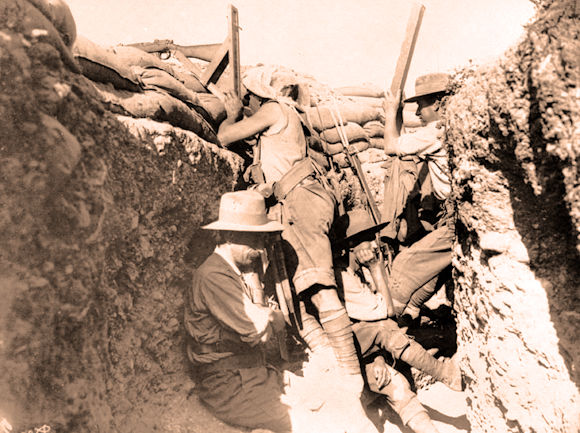 |
| Anzac Second (Front) Line |
Quinn's Post, named after Major Hugh Quinn, 15th Battalion (Queensland) AIF, was one of the most dangerous places at Anzac. "Men passing the fork in Monash Valley," wrote Charles Bean, "used to glance at the place (as one of them said) as a man looks at a haunted house." Quinn's was positioned on the northern edge of the front line along Second Ridge, and beyond was Deadman's Ridge, from which the enemy could fire into the side of the post. Other Turkish trenches lay opposite, and the Turks had only to advance a few meters, capture Quinn's, and the whole Anzac area could be lost.
 |
| The Most Forward Position at Quinn's Post |
Until the end of June 1915, the struggles at Quinn's between Turk and Anzac were ferocious and intense. To raise one's head above the trench was to invite death from a sniper's bullet. The fighting was marked by bomb-throwing by both sides into the enemy trench, and, early on, the Turks had the better of this as the Anzacs lacked bombs. Eventually, a "jam tin" bomb factory was established and the Anzacs could hit back.
On 19 May the Turks launched a major attack on the whole of the Anzac position. At that time, B Squadron was part of the defense of Quinn’s Post. A total of 42,000 Turks took part in the attack but were successfully repulsed, suffering over 10,000 casualties.
 |
| Quinn's Post Viewed from Monash Gully |
During the armistice of 24 May, 2nd Light Horse supplied a burial party of 50 men. According to a statement of a Turk subsequently captured, Mustafa Kemal worked as a sergeant with one of the Turkish burial parties. He was impressed with the extraordinary opportunity the position at Quinn’s afforded, after having stood in front of that post and looked over the Australian trenches straight down the slope in the rear.
Tunnels were dug out from the post to intercept and destroy Turkish tunnels, but at 3:30 a.m. on 29 May 1915, an enemy mine exploded under a section of Quinn's and the Turks rushed into the post. Desperate fighting took place in the dark trenches, but a determined Australian assault broke through and captured 17 prisoners. Among the 33 Australians who died that morning were 11 men of the 13th Battalion, who were smothered in the initial Turkish explosion.
 |
| Reinforcements After the 29 May Mine Detonation |
While the fighting at Quinn's was constant, after June its intensity lessened somewhat. On 9 June 1915, the New Zealand Wellington Battalion, led by Lieutenant-Colonel William Malone, took over at Quinn's and transformed it for the garrison into something which, if never safe, was moderately habitable. Charles Bean reported how he took tea with Malone on a little terrace in front of his dugout and that Malone told him that "the art of warfare is the cultivation of the domestic virtues."
Sources: Australian Veterans Department; Lighthorse.org

No comments:
Post a Comment